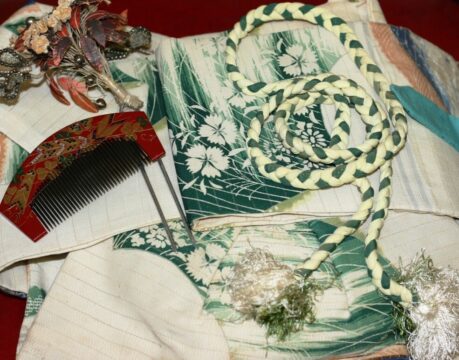
This month Rosenberg Library exhibited a collection of items acquired by Galveston businessman George Sealy II during a trip to Japan in the late 1930s. The collection includes decorative hair accessories, silk obis, and braided kimono cords. These items were donated to Rosenberg Library in 1939.
Born in Galveston in 1880, George Sealy II was the eldest child of George and Magnolia Willis Sealy. With the untimely death of his father in 1901, George Sealy became the family patriarch just after graduating from Princeton University. Responsible for the family’s finances and business holdings, he followed in his father’s footsteps becoming one the city’s most prominent businessmen and civic leaders.
Sealy was president of the Galveston Cotton Concentration Company and served as chairman of the board for Hutchings-Sealy Bank. He was treasurer of the Galveston Cotton Exchange and Board of Trade and a director of the Gulf, Colorado, and Santa Fe Railway. Sealy also served as the city’s commissioner of finance. In addition to his business interests, Sealy was an avid gardener with a particular fondness for oleanders. He cultivated more than sixty distinct varieties of oleanders in a 14-acre nursery he established on the island.
In 1939, while serving as president of the Galveston Wharf Company, Sealy received a special invitation from Kenzo Ito, the consul of Japan at New Orleans. Ito asked Sealy to represent the Galveston Chamber of Commerce as a guest of the Japan Trade Federation. In June 1939, Sealy took a train from Galveston to San Francisco, California. There, he boarded a ship to Japan where he spent six weeks. During the tour, Sealy met with Japanese leaders in effort to further strengthen relations between the Port of Galveston and Japan. At the time, Japan was already a leading importer of goods shipped from Galveston.
Sadly, the once amicable relationship between Galveston and Japan changed shortly afterwards. When the Japanese government allied itself with Germany and Italy during WWII, the United States (still not officially engaged in the global conflict) responded by prohibiting the export of military supplies such as aviation fuel, steel, and scrap metal to Japan in July 1940. When the Japanese attacked the Pacific fleet at Pearl Harbor in December 1941, President Franklin D. Roosevelt requested a formal declaration of war which was granted by the U.S. House of Representatives.
During the Second World War, Sealy — a veteran of the WWI — served as Chairman of the Galveston County War Finance Committee, working to raise funds to support the American effort to defeat Japan and Germany.
George Sealy II died in November, 1944 after contracting pneumonia during a trip to New York. He was survived by his wife, Eugenia Polk Taylor Sealy, and the couple’s three children.